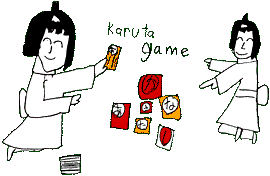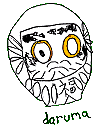I found this lovely account of Japanese New Year traditions at http://www.zuzu.org/japan.html
AKEMASHIE OMEDETO GOZAIMASU! - HAPPY NEW YEAR!
by Achur, age 12 - illustrations by Alex, age 10

The most important and most celebrated part of the holiday season in Japan is New Year's day, known as O-Shogatsu. It's a very busy time between the 24th of December, when school gets out, and the first of January.
Before the New Year, Japanese people clean their houses from top to bottom. Then they put up New Year's decorations, especially Kadomatsu which are made from bamboo, pine branches and strips of white folded paper. When the house is clean and decorated, then everybody gets busy preparing New Year's food.
One of the most important New Year's foods is Mochi. In our neighborhood, we have a mochi-tsuki party every year and make our own mochi. We gather on a Sunday morning in an empty lot. In one corner of the lot, someone starts to cook rice on an open fire. When the rice is cooked, it is placed in a special wooden dish and is pounded with a big wooden hammer. All of the neighbors take turns pounding until the rice mixture becomes a big ball of dough. Then everyone gets involved rolling small mochi balls which are eaten with different kinds of sweet or salty sauces and toppings.
 On New Year's Eve, Japanese people spend time at home with their family. They eat, play games, and watch special New Year's shows on television. Just before midnight, people can also watch temple ceremonies on t.v. where a huge gong is stuck 108 times to wipe away the 108 sins of the past year.
On New Year's Eve, Japanese people spend time at home with their family. They eat, play games, and watch special New Year's shows on television. Just before midnight, people can also watch temple ceremonies on t.v. where a huge gong is stuck 108 times to wipe away the 108 sins of the past year.Although Christmas cards exist in Japan, most people send traditional New Year's postcards called Nengajyo. Some people sends hundreds of them. This custom is very nice because if you post your cards by a special date in December, the post office will deliver them all bright and early on the 1st of January. When you wake up on that day, your mailbox is full of happy wishes for you.
After New Year's breakfast, people get dressed up in their kimonos to go to the shrine or to the temple to pray for good luck and good health in the new year. This is the first temple visit of the year and is very important. After praying, people visit the temple market. All around the temple grounds, there are booths and little shops set up where you can buy traditional foods, cotton candy, balloons, toys and temple souvenirs.
 Daruma can also be purchased at the temple market. These are papier-mache figures that come in many sizes and that have two big white eye spots. Daruma are used for making New Year's resolutions. With a magic marker, the buyer blackens in one of the eyes while making a resolution. If, during the year, they accomplish their wish, they can blacken the other eye to show they succeeded. At the end of the year, people return used darumas to the temple for a special burning and buy new ones.
Daruma can also be purchased at the temple market. These are papier-mache figures that come in many sizes and that have two big white eye spots. Daruma are used for making New Year's resolutions. With a magic marker, the buyer blackens in one of the eyes while making a resolution. If, during the year, they accomplish their wish, they can blacken the other eye to show they succeeded. At the end of the year, people return used darumas to the temple for a special burning and buy new ones.After visiting the temple, Japanese people return to their homes to eat, play traditional games and just relax. Children fly kites and play with wooden tops. Adults play poetry games and pratice calligraphy.
 Probably the most important holiday tradition for Japanese children is O-toshidama. These are little envelopes containing money that children get from their parents and other relatives. Even though the Japanese holidays are very different from holidays in America and Europe, since children are expected to be good all year in order to get O-toshidama, in a way, it is just like Christmas.
Probably the most important holiday tradition for Japanese children is O-toshidama. These are little envelopes containing money that children get from their parents and other relatives. Even though the Japanese holidays are very different from holidays in America and Europe, since children are expected to be good all year in order to get O-toshidama, in a way, it is just like Christmas.Achur, Adam and Alex are from Latham, NY. In 1991, they moved with their family to Tsukuba, Japan, where they are the only foreign students in their small Japanese school. The first year was hard, but now they can speak, read and write Japanese very well. Their little brother Alex, age 4, started Japanes Yochien (kindergarten) this year and loves it!
- originally published in the Holiday 1993 issue of ZuZu
happy new year! thanks for the reminder of japanese NY traditions. i also remember throwing beans in the corners of the house to ward off evil spirits and for good health but i think that is more associated with the lunar new year in feb.
ReplyDeletebtw- like the new pic at the top!
I loved this post! New Year in Japan sounds lovely doesn't it. Happy New Year to you and your family...AKEMASHIE OMEDETO GOZAIMASU! :-)
ReplyDeleteAh yes. And you can also buy a little piece of paper with your fortune on it while you are at that temple. AND, if it is not a good one, you tie it on a tree twig and leave it there!
ReplyDeleteKo toshi mo yoroshiku!